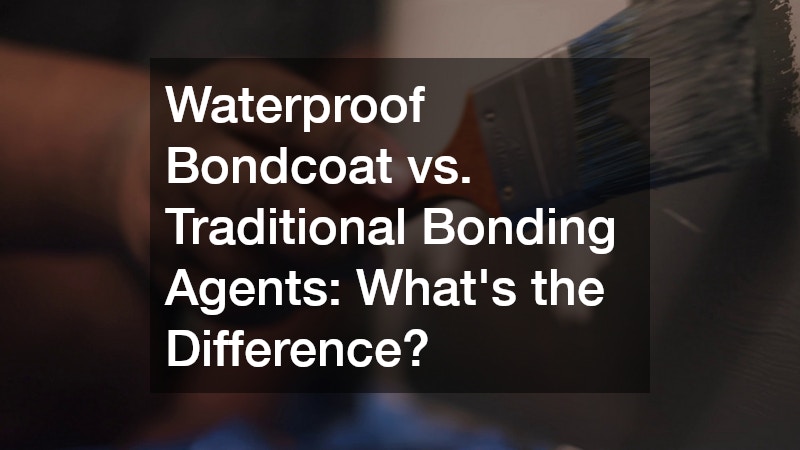

In the realm of construction and renovation, choosing the appropriate bonding agent is crucial for durability and performance. This article explores the distinctions between waterproof bondcoats and traditional bonding agents, providing insight into their applications and benefits.
What Is the Function of a Bonding Agent?
Understanding Bonding Agents
Bonding agents are materials used to enhance adhesion between surfaces that are usually incompatible. They serve as an intermediary layer that promotes the binding of two distinct materials, ensuring a strong bond and durable structure.
These agents are critical in construction, as they enable materials like concrete and plaster to adhere to surfaces that might otherwise resist bonding. Their chemical composition is designed to bridge the physical and chemical properties of the surfaces being joined.
The development of bonding agents has revolutionized the construction industry by allowing for repairs, extensions, and composite material creation that maintain structural integrity. Advances in material science continue to improve their effectiveness, offering new solutions for modern construction challenges.
Applications in Construction
Bonding agents are indispensable in situations where old and new materials need to be joined, such as in the repair of existing structures or in new construction extensions. They provide assurance of a stable and enduring connection across varied construction tasks.
For instance, bonding agents are often employed when applying new cement or mortar over existing structures, ensuring that the new applications firmly adhere to the old. This is crucial in projects requiring refurbishment or updates to existing infrastructure.
Additionally, bonding agents are instrumental in preventing delamination and cracking, which can compromise the longevity and appearance of construction projects. They play an essential role in ensuring that construction projects meet both aesthetic and structural requirements.
Are Waterproof Bondcoats More Effective Than Traditional Bonding Agents?
Comparison of Performance and Durability
Waterproof bond coats are designed to provide an added layer of moisture resistance, enhancing the durability of structures in wet conditions. This characteristic makes them particularly effective in environments where moisture exposure is a significant concern.
Traditional bonding agents, while reliable in many situations, may not offer the same level of protection against water infiltration over time. The composition of waterproof bondcoats enables them to maintain their integrity even under prolonged exposure to moisture.
Ultimately, the choice between waterproof bondcoats and traditional bonding agents should consider the project’s specific needs, including factors such as expected exposure to moisture and climate conditions. In environments prone to high humidity or frequent rain, a waterproof bond coat may offer superior performance and longevity.
Suitability for Different Environments
Waterproof bond coats excel in environments where moisture poses a significant risk to structural integrity. They are specifically designed to function as a moisture barrier, maintaining bond strength irrespective of wet conditions.
Conversely, traditional bonding agents are versatile and effective for various applications, but they may not perform optimally in consistently damp environments. Their performance can degrade over time if exposed to moisture without additional waterproofing measures.
Traditional bonding agents may suffice for projects in dry environments or where moisture is effectively controlled. However, in climates with high rainfall or for structures that encounter frequent water exposure, waterproof bond coats present a more reliable solution.
What Are the Key Benefits and Drawbacks of Each Option?
Advantages and Disadvantages of Waterproof Bondcoats
Waterproof bond coats provide the primary benefit of ensuring durability in moisture-laden conditions. Their application can prevent problems associated with water damage, such as efflorescence and structural degradation.
However, they can be more expensive than traditional bonding agents, which might influence project budgeting. Additionally, their specialized application may require specific techniques or professional installation, increasing overall project costs.
Despite these potential drawbacks, the investment in waterproof bondcoats can be justified for projects prioritized by longevity and resistance to moisture exposure. Understanding the specific project requirements is crucial when considering their use.
Pros and Cons of Traditional Bonding Agents
Traditional bonding agents are often more economical, making them a cost-effective choice for many construction projects. They offer versatile application and generally do not require special handling or installation processes.
Nonetheless, their vulnerability to moisture can limit their effectiveness in certain environments. If used inappropriately, they might fail to provide the necessary structural adhesion, leading to issues like delamination or surface failure.
When using traditional bonding agents, it’s essential to consider the environment in which they are deployed and apply additional protective measures if necessary. Their benefits are maximized in controlled conditions where moisture is minimal or absent.
After comparing waterproof bondcoats and traditional bonding agents, it’s clear that each has its place in construction, depending on project-specific needs and environmental considerations. Waterproof bondcoats excel in moisture-intensive environments, offering superior protection against water-related damage.
Traditional bonding agents, meanwhile, serve as a reliable, cost-efficient choice for many construction scenarios, assuming their environmental conditions are well-managed. Understanding their distinctions helps in making an informed decision for any construction or restoration project.
Ultimately, the choice between these bonding solutions must weigh the project’s unique requirements, budget constraints, and long-term durability expectations. Selecting the appropriate agent can significantly impact the success and longevity of construction endeavors.







